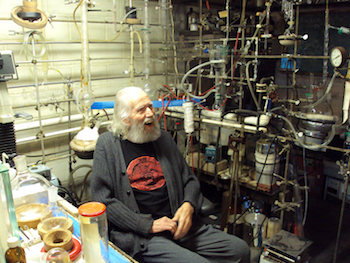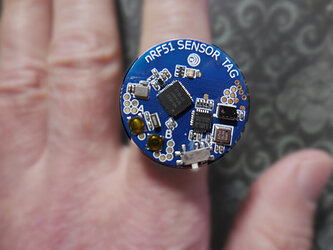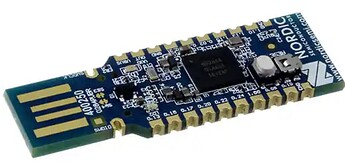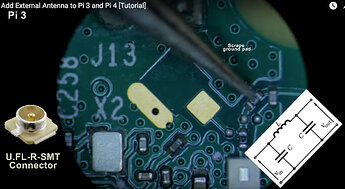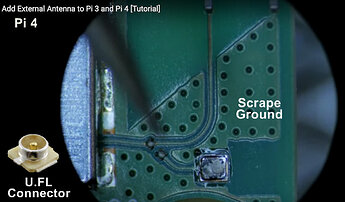It seems the use DIN plug MIDI is diminishing, USB being the new standard?
With DIN plug and Bluetooth being mutually exclusive on the Pi, one has to wonder which should be active by default. I imagine the less tech. savy users are more likely to use BT MIDI keyboards.
As far as a clean future implementation:
The Compute Module 4 has a regulator certified, SMA connector external antenna (discussed mainly in the context of WiFi)
Compute Module specs. include:
“Bluetooth 5.0, and BLE with onboard and external antenna options”
Adafruit is offering what appears to be the official external antenna for $5. Pi CM4 antenna specs sheet ZynthianOrg Folks: the regional compliance data might be of use.
The current model calls for some sort of compromises, cut antenna window in the metal case, experiment with audio board shielding to minimize interaction with the radio, use either an external USB Bluetooth adapter or external DIN MIDI adapter to to allow both to coexist.
The last breakthrough report I ran across:
sidor Feb 3
Just wanted to add that I’ve successfully paried a Bluetooth MIDI device on my custom Zynth with the onboard Bluetooth device using this guide (in case anyone else find it useful):
. - - - - - - - - - - - - - - - -
Regarding latency in Bluetooth MIDI, this 2019, 30 page study should be informative.
Practical Considerations for MIDI over Bluetooth LowEnergy as a Wireless Interface
(They discuss other wireless methods as well)
End-to-End Latency Measurements
Connection. . . . . . . . . . . . . . . . . Latency. . . . . Std Dev
USB MIDI (Teensy). . . . . . . . . 4.1 ms. . . . . . . . 0.4 ms
USB MIDI (Teensy). . . . . . . . . 5.1 ms
USB-Serial (custom). . . . . . . . . 6.2 ms. . . . . . . 0.35 ms
BLE MIDI (custom). . . . . . . . . . 19.1 ms. . . . . . . 2.7 ms
BLE MIDI (minimal). . . . . . . . . 7.5 ms. . . . . . . 1.8 ms
WiFi RTP-MIDI (minimal). . . .8.5 ms
WiFi OSC (minimal). . . . . . . . . 7.6 ms
WiFi OSC. . . . . . . . . . . . . . . . . . . . 6.7 ms
BT 2.0-Serial. . . . . . . . . . . . . . . . 30 ms
BLE*. . . . . . . . . . . . . . . . . . . . . . . . . 139 ms
Round-trip Delay of wired and BLE interface
Connection. . . . . . . . . . . . . . . Round-trip. . . Std Dev
Wired Computer 1 to 2. . . . . . 4.3ms. . . . . . 2.2ms
BLE Computer 1 to 2. . . . . . . . 29.9ms. . . . . 16.0ms
Select Available BLE Devices (in 2019)
Manufacturer. . Model. . . . . . Device Type
ACPAD. . . ACPAD. . . . . . . . . . . Guitar Controller
CME. . . . . . X-Key Air. . . . . . . . . Keyboard Controller
CME. . . . . . WIDI Bud. . . . . . . . . . USB-BLE MIDI Adapter
Isla. . . . . . . KordBot. . . . . . . . . . . . Chord Controller
Livid. . . . . . Minim. . . . . . . . . . . . . . Control Interface
Korg. . . . . . nanoKey. . . . . . . . . . . Keyboard Controller
Quicco. . . . . mi.1. . . . . . . . . . . . . . . MIDI to BLE MIDI
Roland. . . . Aerophone. AE-05. . Wind Controller
ROLI. . . . . . . Blocks. . . . . . . . . . . . . interfaces
ROLI. . . . . . Seaboard. . . . . . . . . . . Keyboard Controller
Sensel. . . . . Morph. . . . . . . . . . . . . Reconfigurable Interface.
Yamaha. . . MD-BT01. . . . . . . . . . MIDI to BLE MIDI.
Yamaha. . . UD-BT01. . . . . . . . . . . USB-Host to BLE
Zivix. . . . . . jamstik. . . . . . . . . . . . . . MIDI Guitar Controller
. - - - - - - - - - - - - - - - -
One forum thread seemed to agree that BT MIDI is usable, except for MPE. (MIDI Polyphonic Expression)
That 220 pound CS-80 “Blade Runner Keyboard” had polyphonic aftertouch (but predated MIDI)
There are other latencies you learn to adapt to.
Aside from commercial Bluetooth controllers, their are also a number of potential cell phone based gadgets that would link through MIDI
For the rare need of an expression pedal, one guy demonstrates a web page script that converts phone rotation into a control signal, 2 axis MIDI signals could be sent from the tilt sensors that all our phones have.
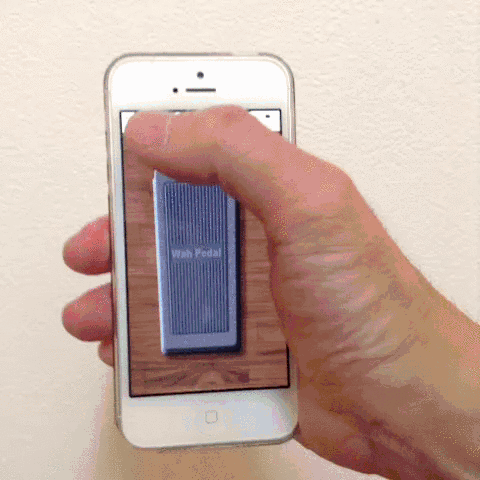
The Demo Page - - - - - The Github Source
The last time I saw Neova modulation ring in NAMM videos it still had a wire, I see it’s now a polished finished product.
(Judging by the size it probably used BLE with a proprietary data format link to their receiver/charger) 1:15 demo
https://www.youtube.com/watch?v=kgpN8uCEUR4
(You can see 5 minutes of pros trying it at NAMM)
At 399€ it’s probably not an effective add-on aftertouch for cheap keyboards. (Wave Ring prototype analyses, no intermediate box?)
. - - - - - - - - - - - - - - - - - - -
You could make an Elton John sized facimile using a bluetooth Badge, Beacon or Fitness monitor with an accelerometer.
Bluetooth 3 axis accelerometer sensor module ble $9.14 accelerometer proximity beacon sensor nRF51822 bluetooth radio, STmicro lis2dh12 accelerometer ±2g/±4g/±8g/±16g data rates from 1 Hz to 5.3 kH, 26mm dia (no programming pads?)
I have one of these surplus 30mm badges loaded with sensors:
(Had in mind to use in for a Guitarists ring, pick holder)
NRF52832 SENSOR R40: accelerometer, gyroscope, altimeter, ambient light, 2 push buttons 4.0BLE, coin battery (no case) China
I scrounged some documentation I hope I have not lost
$16.02 . . $18.61 . . $20.28
. - - - - - - - - - - - - - - - - - - -
I bought but have yet to play with the * Nordic Semiconductor ASA NRF52840-DONGLE for a bargain $10 (meant as an engineering toolthe supply does’t appear to be limited.
It uses their new BT5 chip with a fairly potent processor, BT5 get something like 4X the range and double the speed of BT4. Could perhaps be used in pairs for a select-able, enhanced propitiatory performance Bluetooth link (The dongle doesn’t have the debugging facilities of a larger eval board)
. - - - - - - - - - - - - - - - - - - -
More WiFi connect options would be useful as well, perhaps an alternative to VNC that sends compact display state specifications instead of a screen shot, could make a mobile device front panel interface to a headless version perform more like the real deal.
I suppose a WiFi MOD-UI edit page connection to a tablet would be miserably slow, but a useful kluge in a pinch if there’s no desktop/lap computer with eithernet handy.
It’s just lucky the Zynthian Corporate engineering staff is ready to fulfill our unrealistic re-engineering dreams.
